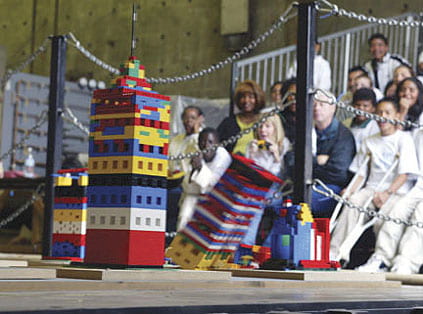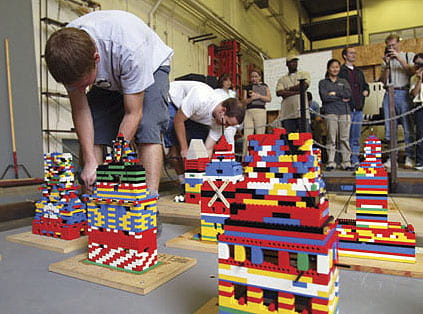Shake, rattle and roll
Earthquake simulations offer young students the thrills – and spills – of university research
There’s a whole lotta shakin’ goin’ on at UCI’s Henry Samueli School of Engineering – all to the cheers of young Southern California students.
Yelling, clapping and stamping their feet on bleachers, hundreds of disadvantaged youngsters fill an engineering laboratory to watch a simulated earthquake knock the bricks from their hand-constructed LEGO® buildings.
The shake-down competition culminates an earthquake-education outreach program presented by the Department of Civil and Environmental Engineering as part of its participation in the Pacific Earthquake Engineering Research Center. Created and partially funded by the National Science Foundation, the center’s mission is to develop performance-based earthquake engineering technologies to meet the economic and safety needs of property owners and society.
Directed specifically toward Pacific region problems, the center unites the efforts of experts in Earth sciences, engineering and social sciences from 18 universities in seven western states.
For the young students in the program, West Coast earthquakes become very personal. “The kids get emotionally charged,” says Professor Gerard Pardoen, a structural and earthquake engineer and the program’s creator. “They believe their structures are strong enough to survive, then they see the devastation the shaking causes.”
A FIRM FOOTING
Four years ago, Pardoen developed the program in conjunction with the university’s outreach efforts to share its facilities and staff in educating young students. The program has proved so successful that UC Berkeley and UC San Diego are creating their own versions. Now Pardoen co-directs the program with engineering colleague Tara Hutchinson.
In years past, students in grades three through 12 have participated in the program. Despite lean financial times, Pardoen says, a team effort by engineering faculty and university outreach officials has been able to maintain funding, though this year the program can be offered only to grades six through 12.
To prepare for the program, teachers attend an educational seminar presented by university students and staff. Using lesson plans based on UCI materials, the teachers return to their schools to conduct classes in earthquake education, basic structural engineering and architectural design.
Some teachers in the program invite architects and contractors into their classrooms to explain their views on building.
Teams of students then work together in a fun competition to see whose toy structures are the toughest. In addition to testing their structures against earthquakes, the students must conduct research to answer such questions as, “What is a G?” and “What is the difference between a 6 and a 7 on the Richter scale?” University staff suggest Web sites where students can collect the information.
The students also must learn how a building’s looks are determined. A critical question: “Who influenced the team’s design the most – an architect, structural engineer, contractor or building owner?”
“Each of these ‘stakeholders’ take part in a building’s design,” Pardoen explains, “For example, if an engineer alone were to design a building, it might have no entrances – no doors or windows. You couldn’t get into it, or see out of it, but it would always remain standing. Architects, on the other hand, often like to have flying buttresses and lots of flair in a building’s design.”
READY TO RUMBLE
The program culminates in May when the students come to UCI for the day-long competition in which they vie for the best scores on both written materials and oral presentations. Their tiny buildings also win points for design, height, number of LEGO pieces used and stability on the “shake table” – a large platform rigged to simulate the vertical, horizontal or rolling effects of varying-strength earthquakes. The table is used by UCI researchers to test materials and designs for earthquake resistance.
During the program’s early development, Pardoen and the rest of his volunteer team had a few problems to overcome. An engineering student tested a LEGO model on the shake table set to simulate the 1994 Northridge earthquake. The miniature structure easily withstood the quick jolt.
“I thought, ‘Oh no, we’re going to have 45 winners,’” Pardoen recalls. So the test was quickly changed to include three increasing levels of motion, with the last being the newly named “UCI rumble.”
“We just let it rip at its maximum,” he says. Since the shake table is anchored to the laboratory floor, its vibrations can be felt throughout the lab.
“That’s when the kids get really excited,” Pardoen says.
CAPTURING IMAGINATIONS
The outreach effort, sponsored by UCI’s Center for Educational Partnerships and the National Science Foundation-funded FOCUS program, also provides students increased exposure to university life.
“What’s most important is that these kids, who likely have never been on a university campus, get to visit a world-class research facility,” Pardoen says. “We want them to see 19-year-old students, not that much older than they are, running the shake table. Hopefully, we’ll make an impression on them, and they will start thinking about attending a university – maybe even this one.
“The LEGO program has a special appeal,” Pardoen says. “It has captured the imaginations of the students, whose buildings stand or fall in the competition, and the attention of the media.”
He recalls a broadcast last fall on CBS Radio’s “The Osgood File,” which quoted co-director Hutchinson. “When the shaking began, so did the shouting,” she said. “It’s amazing to see kids jumping out of their seats, cheering for an engineering contest as if it were a basketball game.”




